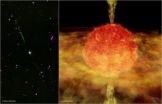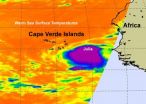(Press-News.org) An astronomer may have caught a cannibalistic star in the act of devouring a companion and making a second generation of exoplanets from the resulting orbiting disk.
Using data from NASA's Chandra X-ray Observatory, Joel Kastner, professor at Rochester Institute of Technology, has found evidence that a variable star in the constellation of Pisces, BP Piscium, is not the young star it appears to be, but is more likely a one billion-year-old red giant that has gobbled up a star or planet in its vicinity.
The star's extreme properties have puzzled astronomers since Kastner and Ben Zuckerman, professor at the University of California, Los Angeles, first looked at BP Psc 15 years ago. Conflicting characteristics have defied the star's classification as either young or old.
Kastner attributes the star's potentially deceptive youthful appearance to two things: an orbiting disk that resembles the sort that forms planets around young stars and prominent jets extending from the poles of the star that eject material at high velocity. A typical young star accretes material from its orbiting disk as debris from the disk falls onto the star. In turn, the star incorporates about 90 percent of the material and recycles the remainder through its jets.
Crucial details left Kastner and his colleagues doubtful about the youth of the star, however. For one thing, the star is isolated, whereas most young stars form in clusters.
"As hard as people have looked, they have not been able to find a young star near BP Psc," says Kastner, a professor in RIT's Chester F. Carlson Center for Imaging Science. "That was one of several things that made Ben [Zuckerman] and me suspect that it wasn't actually young."
Second, this enigmatic star in the Pisces constellation lacks the large abundance of lithium on its surface that is typical of young stars. Older stars lose their lithium in nuclear reactions when mixing and churning folds the gases into the center of the star. According to Kastner, other key spectral features involving the star's radius and surface gravity also point to the star's advanced age.
Kastner is ready to close the debate with data obtained from the Chandra X-ray Observatory.
"The last piece of evidence, which, to me, is the nail in the coffin that BP Psc is old rather than young, is that its rate of X-ray production is very similar to old, yet rapidly spinning, giant stars that have surface temperatures similar to BP Psc," Kastner says.
If BP Psc were a young star, it would emit X-rays in the hundreds, even up to a few thousand, in a day's observing time with Chandra, Kastner notes. Instead, it is a weak X-ray source.
"We stared at BP Psc for one day with Chandra and only detected about 18 X-rays," Kastner says. "We could almost name them."
The rate of X-rays coming from the star are in keeping with a class of rapidly rotating old stars having similar temperature to BP Psc, Kastner says. This class is thought to be the result of one star swallowing another close companion star. These giant stars' rates of X-ray production and their rapid spinning suggest they have engaged in such stellar cannibalism.
"These giant stars' companions have fallen inside and spun them up," Kastner says. "But we've never actually caught one in the act. I think BP Psc is an example of such an interaction. Our working speculation is that we are observing the star right at the point at which it has swallowed its companion and hence formed a disk. Some of the material that used to be its companion has fallen onto the star and some has been shot out at high speeds, and that's what we're seeing."
The enigmatic star is likely about a billion years old and just entering the red giant stage in its life cycle in which it swells to digest its star or planet companion.
"It could be a small star or a large planet," Kastner says. "We don't know which it could be, but we're very interested in finding out."
More work needs to be done on the variable star in Kastner's study. Astronomers are presently deciphering infrared spectra to determine the specific kinds of dust orbiting the star and look for evidence of planets forming in the disk.
"In order to understand the extrasolar planets that are now being discovered by the dozen, we need to figure out how planets might be forming and therefore where we should go look for them," Kastner says. "I think this object is especially interesting because it gives us a good shot at finding young planets around an old star."
INFORMATION:
Kastner's findings were published in a recent issue of the Astrophysical Journal (Letters), and include contributions by Rodolfo Montez, a doctoral candidate in the astrophysical sciences and technology program in RIT's Center for Imaging Science. Other co-authors were Nicolas Grosso of the University of Strasbourg, Ben Zuckerman from University of California, Los Angeles, Marshall Perrin from the Space Telescope Science Institute, Thierry Forveille of the Grenoble Astrophysics Laboratory in France and James Graham from University of California, Berkeley.
About RIT: Rochester Institute of Technology is internationally recognized for academic leadership in computing, engineering, imaging technology, and fine and applied arts, in addition to unparalleled support services for students with hearing loss. Nearly 17,000 full- and part-time students are enrolled in more than 200 career-oriented and professional programs at RIT, and its cooperative education program is one of the oldest and largest in the nation.
For two decades, U.S. News & World Report has ranked RIT among the nation's leading comprehensive universities. RIT is featured in The Princeton Review's 2011 edition of The Best 373 Colleges and the 2011 edition of The Fiske Guide to College.
Enigmatic star devours companion; possibly pregnant with second-generation planets
RIT astronomer wraps up 15-year study of star in Pisces constellation
2010-09-14
ELSE PRESS RELEASES FROM THIS DATE:
International Fertility Societies call for harmonization of cross-border reproductive care standards
2010-09-14
"The IFFS's 'Surveillance 2010' report, compiled by Professor Ian Cooke and published on 14 September 2010, illustrates this for over 100 countries. The survey highlights how widely assisted reproductive technologies (ART) are being used and how different cultures are regulating services in different ways. In most countries there is no state or insurance support, so these services are costly and frequently beyond the reach of many families. In some countries access to donor gametes is denied or supply is limited.
To address the safety of patients that seek treatment abroad, ...
September/October 2010 Annals of Family Medicine tip sheet
2010-09-14
Low Adherence with Regular Fecal Occult Blood Test Screening Among Insured Patients
In a large U.S. health plan, nearly one-half of patients who initiated biennial fecal occult blood test (FOBT) screening did not adhere to subsequent colorectal screening in the ensuing 2-year period, compromising the effectiveness of the screening endeavor which hinges on regular screening. Analyzing data on 11,110 patients enrolled in a Washington State health plan who completed an FOBT during the baseline period (2000-2001), researchers found 47 percent received no colorectal screening ...
Farm management choice can benefit fungi key to healthy ecosystems
2010-09-14
Farming practices have a significant impact on the diversity of beneficial microbial fungi known to play important roles in crop productivity, soil recovery and maintenance of healthy ecosystems, according to new research published today (14 September 2010) in the journal Environmental Microbiology. The conclusions could have important implications for the way humans manage the agricultural landscape and tackle food security issues.
The study was led by Dr Christopher van der Gast at the Centre for Ecology & Hydrology (CEH), UK and Dr Gary Bending from the University ...
Childhood cancer survivors show sustained benefit from common ADHD medication
2010-09-14
A medicine widely used to treat attention-deficit/hyperactivity disorder (ADHD) also provides long-term relief from the attention and behavior changes that affect many childhood cancer survivors, according to a multicenter trial led by St. Jude Children's Research Hospital investigators.
Researchers reported that one year after starting the drug methylphenidate, young cancer survivors scored better on tests of sustained attention and other measures of attention, social skills and behavior than did a similar group of unmedicated survivors. While taking methylphenidate, ...
Igor now a Category 4 hurricane with icy cloud tops and heavy rainfall
2010-09-14
NASA Satellites have noticed two distinct features in Igor that both indicate how powerful he has become, icy cold, high cloud tops and very heavy rainfall. NASA's Aqua and TRMM satellites have provided that insight to forecasters who are predicting Igor's next move as a powerful Category 4 Hurricane.
Last week, Igor was a tropical storm who faded into a tropical depression. The National Hurricane Center had forecast that over the weekend Igor would approach more favorable conditions (low wind shear and warm sea surface temperatures) causing it to strengthen into a hurricane ...
NASA sees Tropical Storm Julia born with strong thunderstorms and heavy rainfall
2010-09-14
Tropical Depression 12 was born in the far eastern Atlantic Ocean yesterday, Sept. 12 and two NASA satellites saw factors that indicated she would later strengthen into Tropical Storm Julia. Infrared imagery from NASA's Aqua satellite revealed strong convection in its center that powered the storm into tropical storm status by 11 p.m. EDT. NASA's TRMM satellite indicated very heavy rainfall from that strong area of convection.
The Atmospheric Infrared Sounder (AIRS) instrument that flies on NASA's Aqua satellite gives scientists and meteorologists clues about how a tropical ...
Targeted agent shows promise for chronic lymphoid leukemia
2010-09-14
COLUMBUS, Ohio – Researchers at the Ohio State University Comprehensive Cancer Center-Arthur G. James Cancer Hospital and Richard J. Solove Research Institute (OSUCCC-James) have identified an experimental agent that targets chronic lymphocytic leukemia and perhaps other proliferative disorders of lymphocytes.
Their study shows that the small-molecule inhibitor CAL-101 directly promotes cell death by apoptosis in chronic lymphocytic leukemia (CLL) cells and disrupts several external survival pathways needed for CLL cell viability and proliferation.
The agent blocks ...
New task force report on bisphosphonate use and atypical femur fractures in osteoporosis patients
2010-09-14
Washington, DC, SEPTEMBER 14, 2010– A widely prescribed class of drugs is highly effective in reducing common bone fractures in people with osteoporosis, but an expert panel announced today that these same drugs – when used long term – may be related to unusual but serious fractures of the thigh bone. In the most comprehensive scientific report to date on the topic, the task force reviewed 310 cases of "atypical femur fractures," and found that 94 percent (291) of patients had taken the drugs, most for more than five years. The task force members emphasized that atypical ...
New studies highlight benefits of teacher coaching
2010-09-14
A set of studies released in this month's special issue of The Elementary School Journal reveals the powerful effect that the coaching of teachers can have on both teachers and students.
"Many in the field have trusted that intuitive feeling that putting a knowledgeable coach in a classroom to work with a teacher will result in improved teacher practices and increased student learning," write the issue's guest editors, Misty Sailors of The University of Texas at San Antonio and Nancy L. Shanklin of University of Colorado, Denver. "The jury of these researchers and the ...
Study identifies underlying dysfunction of seemingly non-critical heart condition
2010-09-14
Repairing small, seemingly benign holes in a child's heart may be more clinically important than previously thought, as dysfunction could be lurking out of sight. These are the findings from a study conducted by doctors and researchers at Nationwide Children's Hospital and the Ohio State University Medical Center examining a subset of the most common form of congenital heart disease, ventricular septal defect. The recently published study appears in the Journal of Molecular and Cellular Cardiology, the official journal of the International Society for Heart Research.
Ventricular ...
LAST 30 PRESS RELEASES:
Scientists trace microplastics in fertilizer from fields to the beach
The Lancet Obstetrics, Gynecology, & Women’s Health: Taking paracetamol during pregnancy does not increase risk of autism, ADHD or intellectual disabilities, confirms new gold-standard evidence review
Taking paracetamol during pregnancy does not increase risk of autism, ADHD or intellectual disabilities
Harm reduction vending machines in New York State expand access to overdose treatment and drug test strips, UB studies confirm
University of Phoenix releases white paper on Credit for Prior Learning as a catalyst for internal mobility and retention
Canada losing track of salmon health as climate and industrial threats mount
Molecular sieve-confined Pt-FeOx catalysts achieve highly efficient reversible hydrogen cycle of methylcyclohexane-toluene
Investment in farm productivity tools key to reducing greenhouse gas
New review highlights electrochemical pathways to recover uranium from wastewater and seawater
Hidden pollutants in shale gas development raise environmental concerns, new review finds
Discarded cigarette butts transformed into high performance energy storage materials
Researchers highlight role of alternative RNA splicing in schizophrenia
NTU Singapore scientists find new way to disarm antibiotic-resistant bacteria and restore healing in chronic wounds
Research suggests nationwide racial bias in media reporting on gun violence
Revealing the cell’s nanocourier at work
Health impacts of nursing home staffing
Public views about opioid overdose and people with opioid use disorder
Age-related changes in sperm DNA may play a role in autism risk
Ambitious model fails to explain near-death experiences, experts say
Multifaceted effects of inward foreign direct investment on new venture creation
Exploring mutations that spontaneously switch on a key brain cell receptor
Two-step genome editing enables the creation of full-length humanized mouse models
Pusan National University researchers develop light-activated tissue adhesive patch for rapid, watertight neurosurgical sealing
Study finds so-called super agers tend to have at least two key genetic advantages
Brain stimulation device cleared for ADHD in the US is overall safe but ineffective
Scientists discover natural ‘brake’ that could stop harmful inflammation
Tougher solid electrolyte advances long-sought lithium metal batteries
Experts provide policy roadmap to reduce dementia risk
New 3D imaging system could address limitations of MRI, CT and ultrasound
First-in-human drug trial lowers high blood fats
[Press-News.org] Enigmatic star devours companion; possibly pregnant with second-generation planetsRIT astronomer wraps up 15-year study of star in Pisces constellation


